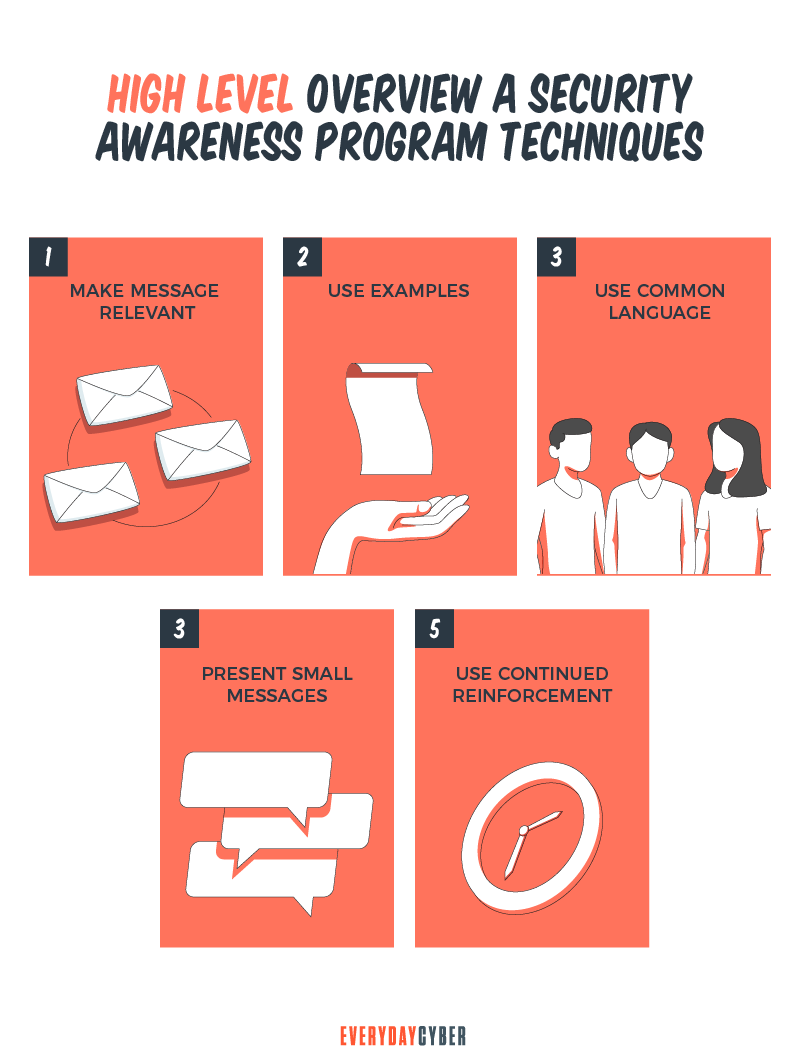Cybersecurity is a major concern for today’s enterprises. In 2025, the cost of cyber crime is expected to reach $10.5 trillion annually. That’s nearly half of the US economy with an estimated value of $22.9 trillion in 2021.
Because of this startling fact, teaching your staff cybersecurity best practices should be at the top of your priority list when it comes to safeguarding your company’s digital assets.
Why Implement a Cyber Security Awareness Program
Cybersecurity is a people issue. Cyber attacks are growing in magnitude, sophistication, and expense. And employees are frequently targeted by cyber criminals. 
Human mistake is responsible for 90% of data breaches in 2019. Phishing, in particular, is a widely used tactic that takes advantage of users’ lack of
It doesn’t matter if you’re big or small
Who would ever suspect that Twitter could become a victim of cyber attack? It happened more than a year ago. According to Twitter, it was a coordinated social engineering effort by hackers. The attackers targeted some of the company’s employees with access to internal systems and tools.
The hacked accounts included a Dutch elected official and celebrities like Kanye West, Elon Musk and Apple chief executive Tim Cook. The hackers did not steal information from the celebrities because they just wanted to promote a bitcoin-based scam.
The Twitter incident proves one thing – that every employee in your company contributes to the success or failure of your
Strengthening the weakest link
It’s indisputable that your employees are your company’s first line of defense against cyber attacks. Yet, they can be the weakest link.
There’s evidence that people are the single most crucial point of failure in terms of cyber threats. Whether intentional or unintentional, human errors in cyber
Employees who are unaware of cybersecurity concerns are more likely to fall victim to phishing attacks. Cyber secure employees have a high level of
Training promotes cyber security awareness
Building a cyber
Cybersecurity training helps teach employees basic cybersecurity knowledge. It should be required for both old and new employees.
You want to make sure that your end-users are protected and that they are using technology safely. Many employees are still unaware of potential risks or are just too preoccupied to care.
This is why you need to make it as simple and painless as possible for training participants to learn about potential vulnerabilities. This is the function of good
Preparing Your Security Awareness Training
Your people have unique cybersecurity needs. This requires training tailored to your organization’s goals and objectives. Don’t rely on generic
Here are some tips to help you prepare your cybersecurity awareness training:
Determine your objectives for the training
Sit down with your cybersecurity training team before you start developing your program approach. This group genuinely cares about the safety of your company.
What should you ask them? They have a wealth of data and stats at their disposal. They will very certainly be able to provide you with a list of high-risk incident categories that they monitor.

What are the top categories that keep bothering them? What are the common sources of the threats? Do they have the skills and tools to stop them? How long does it take for the user and the highly qualified technical staff to resolve each of these incidents? And many more.
Assess your company’s current cybersecurity awareness level
Assess your company’s overall cybersecurity awareness level to help you identify specific areas where you can improve. You can bypass boring, remedial lessons that would induce disengagement with your training program if you identify what your employees already know. How do you do this?
Get feedback on cybersecurity knowledge directly from your employees
You can determine employee knowledge of cybersecurity risks by sending out questionnaire forms for them to complete. Their answers to basic questions on common cybersecurity issues will reveal a lot about how knowledgeable they are about the subject. Are they knowledgeable about phishing, password length, and social engineering tactics, for example?
Send fake phishing emails
Send fake phishing emails to your people and observe how they react. This is a good way to test your employees’ overall cybersecurity knowledge. If a high number of the phony phishing emails go through, you know your training program has to focus on detecting and responding to phishing attacks.

Naturally, these false phishes must be carefully designed in order to prevent employees from sharing potentially sensitive and confidential information.
Conduct random cybersecurity drills
Carry out a series of random drills that imitate various forms of cybersecurity threats. After that, keep track of how employees react to the simulated attacks.
Do they implement strong cybersecurity practices in improving
Running cybersecurity drills like fake phishing campaigns can assist your employees learn how to respond appropriately in a real-life situation. Their reaction to the drill will also indicate how much more training they require.
Set aside a budget for your security awareness training
How much does cybersecurity training cost? The training can cost anywhere from free to $5,000 or more. This will depend on the quality of the training and how much access to hands-on exercises is provided. Higher-cost training programs frequently result in more valued credentials, such as certifications.
Try looking at what other organizations in your industry of similar size spend on cyber awareness training. This will assist you in having a realistic estimate of the final cost of your program. In the end, you don’t need to spend a lot of money to succeed in your program.
Schedule a time frame for employee training
Employees must be able to devote 100% of their attention to training. Employees may neglect to complete training if given only during their spare time. It isn’t part of their primary job function, anyway. And if you aren’t giving them a specific schedule to do it, they may think that the training may not be that vital, after all.
By entering your email address you agree to receive emails from EveryDayCyber. We'll respect your privacy and you can unsubscribe at any time.
Developing Your Cyber Security Awareness Program
You can’t do it on your own. Money and people should be included in a comprehensive cybersecurity training. At this point, you should already have a rough idea of how much your training program will cost.
Now it’s time to find the folks you’ll need. To create an interactive
So what should your training program include?
Essential features to include in your training
Cyber threats are constantly evolving. You’ll need to include features that address these threats.

Engaging content and format
Choose short training courses that are appropriate for your employees’ skill levels. Focus on the users’ main concerns: usability and enjoyment. This will make the training a memorable one, which will help your people learn more effectively.
Reading materials, lectures, videos, infographics and other interactive presentations are part of a good cybersecurity awareness program. But people retain more knowledge from simulations than any other method. Here’s what the National Training Laboratories concluded:
Measurable results
Your
Enforce training module completion
It’s critical to assign time to your employees’ total module completion if you’re putting them through the training with set modules.
Are your employees getting stuck at a certain point in the course plan and dropping out? Get to know where individuals are coming to a halt.
It’s important to keep track of how your training participants are coping with the set schedule. While you can’t expect your staff remember every detail, it’s critical that all participants understand their responsibility in ensuring completion of the training modules.
Conduct training quizzes
Analyze how your people are scoring in quizzes in between modules or after finishing the program. It’s important to look beyond the standard “yes” or “no” answers or “pass” or “fail” criteria to see how teams are truly doing.
More importantly, assess how they answer questions that need critical thinking, such as the why’s and how’s of things. This is where you’ll see if participants need additional support.
Run phishing simulations
If a high number of the phony phishing emails go through, you know your company has to focus on detecting and responding to phishing attempts.
Naturally, these false phishes must be carefully designed in order to prevent employees from sharing potentially sensitive and confidential information.
Give special training for employees with special roles
Do some research to figure out who in your company might be deemed a higher risk. It’s critical to keep your focus on certain individuals of your organization a little more than others once you’ve determined who needs to be observed more closely.
For example, your finance department is more likely to be targeted in phishing attacks because they have access to money. Your C-suite may also be common targets due to their high status and privilege.
Implementing Your Cyber Security Awareness Program
If you can’t get everybody on board, your
Managers who do not exhibit appropriate cybersecurity practices can’t expect their employees to obey the regulations seriously.

Communicate often and effectively with your people. Talk to employees at every department and level. Get to know their needs and weaknesses. Know if they’re learning from their training and give additional support where needed. Create supportive initiatives to employees who are faring well.
How Do You Know If Your Security Training is Working?
Progress cannot be measured in how many times employees took the training, nor on how many clicks they made on a training material. It’s on whether they changed their behavior or not. 
One of the most effective methods to achieve this is to put them through phishing simulations and fake social engineering attacks month after month. That way, you’ll have enough data to create the appropriate metrics for a learning curve. Getting sufficient data will enable you to demonstrate that your program is effective in changing behavior.
By entering your email address you agree to receive emails from EveryDayCyber. We'll respect your privacy and you can unsubscribe at any time.
Recommended Reading
What is a VPN?
A VPN is a virtual private connection to a VPN host server to hide your identity, address and online activity when using a public Internet connection. It does this by encrypting your data and turning them into “rubbish” so no one can make sense of it even if they get their hands on it.
What is a Potentially Unwanted Program (PUP)?
PUPs refer to programs, applications and other software downloaded onto computers or mobile devices that may have an adverse impact on user privacy or security. The term “potentially unwanted program” was coined by McAfee to distinguish the program from malware.
What is a Back Door Threat?
In cybersecurity, a Back Door Threat enables a hacker to gain unauthorized access to a computer or digital device at any time.
What is Whaling?
Whale phishing is a targeted spear-phishing attack in which cybercriminals impersonate the high-level executives of an organization to send messages to lower-level company administrators in a position to do the acts being requested by the criminals on two things they want most -- money and data.
What is a DDoS (Distributed Denial of Service) Attack?
DDoS attack or Distributed Denial of Service, is a coordinated attack intended to crash and make unavailable targeted websites and online systems by overwhelming them with data.
Is a Cybersecurity Risk Assessment Worth the Money?
A cybersecurity risk assessment does more than just identify and analyze threats. It counteracts threats and keeps your IT systems safe.
